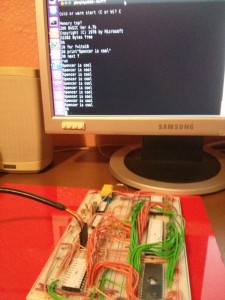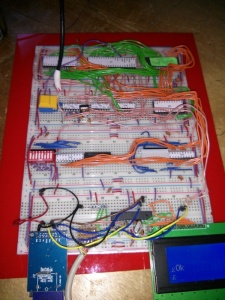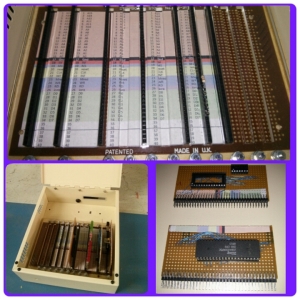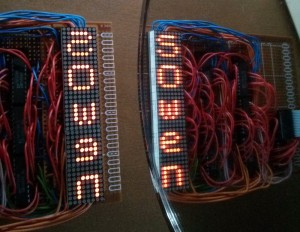Around the end of 2013 I came up with the wild notion that I wanted to build a replica of the Sinclair ZX80. As I’d never done anything like that, I researched what would be required and stumbled upon Grant Searle’s website with plans for an exact replica. As I collected together the various parts needed I delved further in to Z80 based computers and in particular the breadboard based Simple Z80 listed on Grant Searles site.
Over Christmas of 2013 I recreated this on breadboard and was amazed when it actually worked! Not only that, but I could actually get it to do stuff. So I added more and more parts so that I could read switch inputs, light LEDs, display text on a LCD and program it with a real keyboard.
The Computerphile YouTube channel took an interest in what I’d done in march 2014, and made a great video which has had over 75,500 hits so far!
In my mind this was awesome. The breadboard wiring was, however, getting to be a nightmare. When it worked, it was great, but it was quite delicate and not at all easy to troubleshoot or extend. So I decided to transfer it to Veroboard. The backplane part here was easy. Due to the backplane pinout I’d decided upon, the CPU was easy too. As I got the ROM and RAM soldered up I began to realise that this wasn’t actually much easier than the breadboard approach and the project kind of stalled.
In June 2014 I heard about Retro Challenge and debated what I could do to enter. Retro Challenge runs twice a year and the criteria are very open, so basically anything that can be classed as “retro computing” is included. So I set myself the goal of getting the Z80 up and running, learning a bit of assembly language and controlling some LEDs to spell my name.
I had just started to tinker with KiCad, and making custom PCBs seemed like the easy way to go. Bit by bit the boards started to take shape, and in a very transparent ploy to win favour with the judges, I decided to name this computer RC2014. This may have worked as I won the constructors award! The early blog pages detail my progress throughout July.
Following the end of the competition I was keen to build on the work that I’d put in to RC2014 and continued to add to the project. Interest in RC2014 began to grow and in October 2014 I decided to set up this website dedicated to this little modern retro oddity.
A year later enough people had either enquired about getting a set of PCBs, or that I wondered if it would be worthwhile getting a few more boards ordered and listed on Tindie. They sold out pretty quickly, so another batch was ordered, although there was growing interest in buying complete kits with components as well as more options than just the 5 “Bare Bones” modules. Within months I had shipped my first 100 “Full Monty” kit, complete with custom backplane, and a community of enthusiasts were starting to form. By May 2016 things were getting busy enough that I had to quit my full time network infrastructure engineer job to dedicate my time to RC2014…






